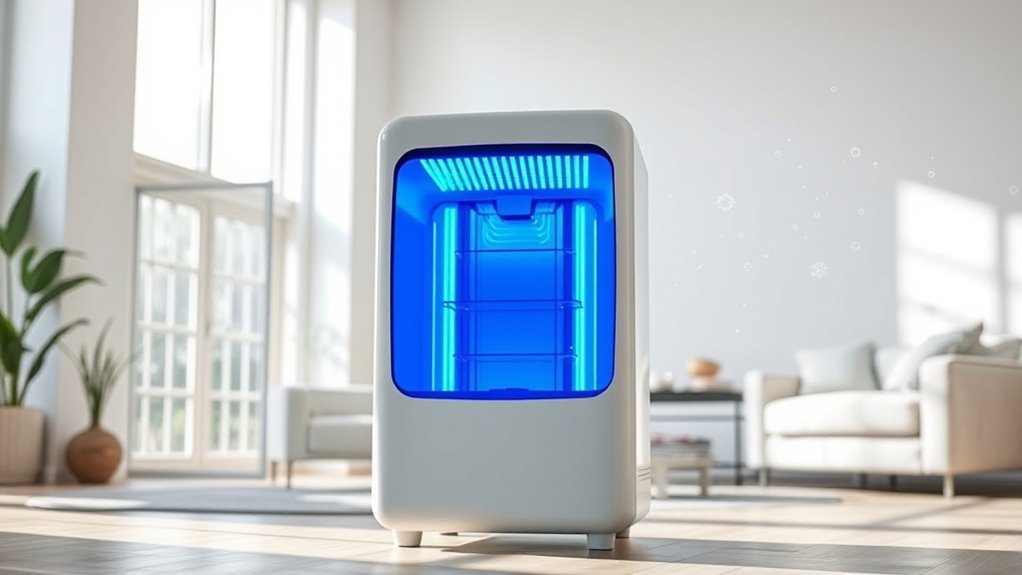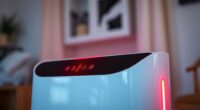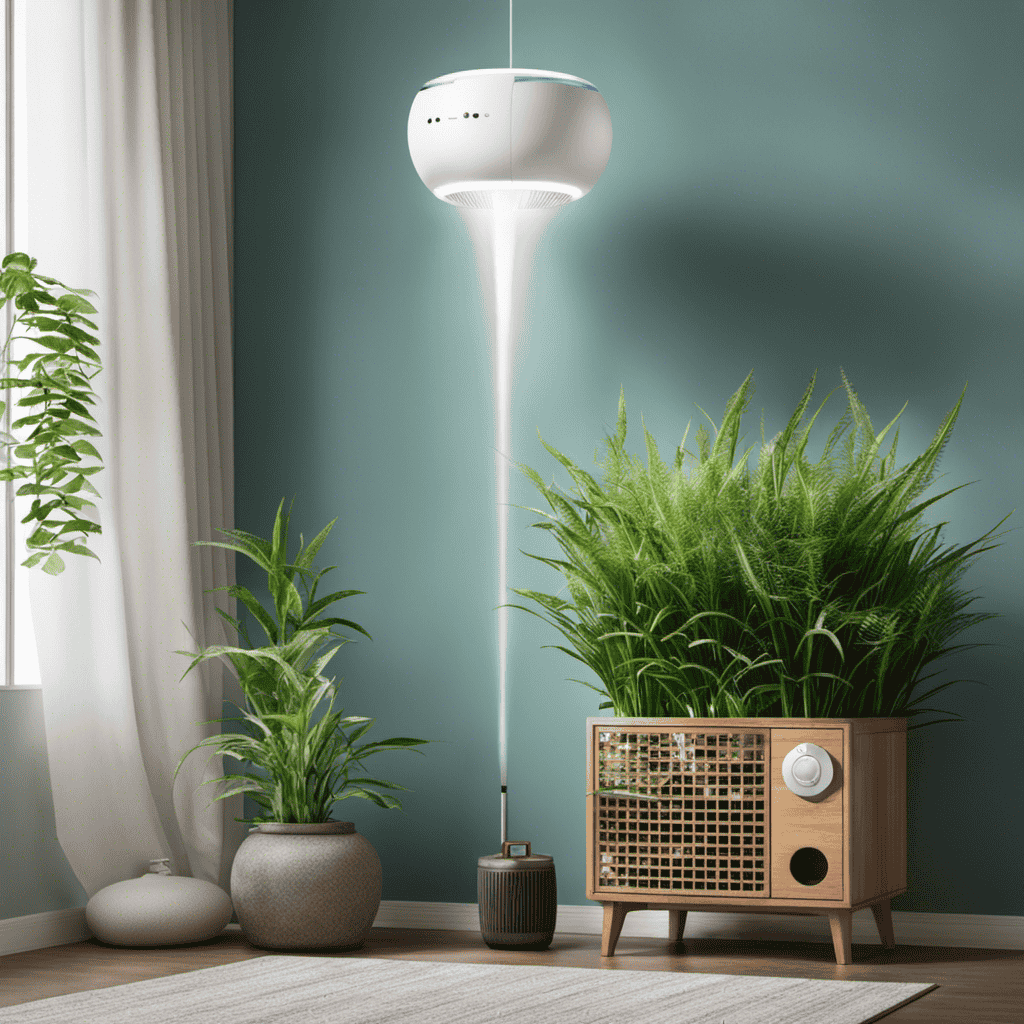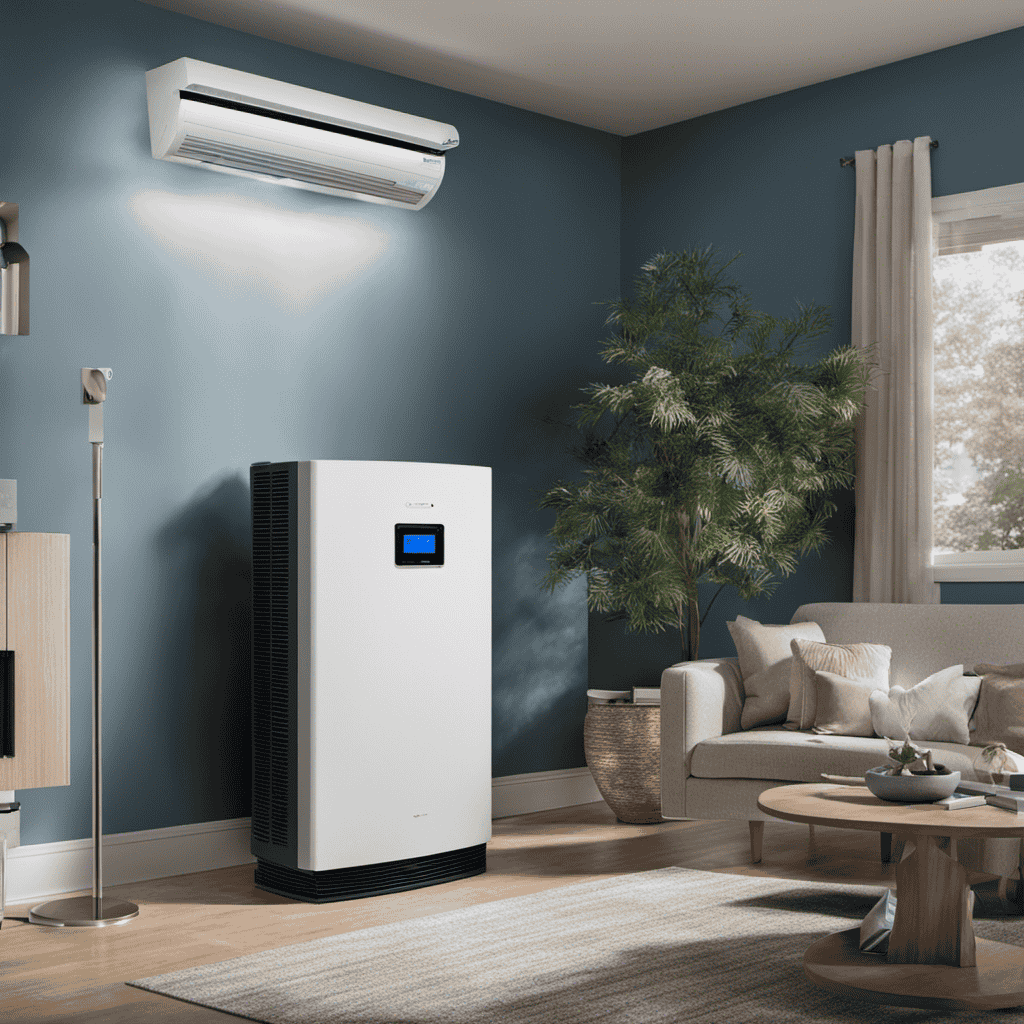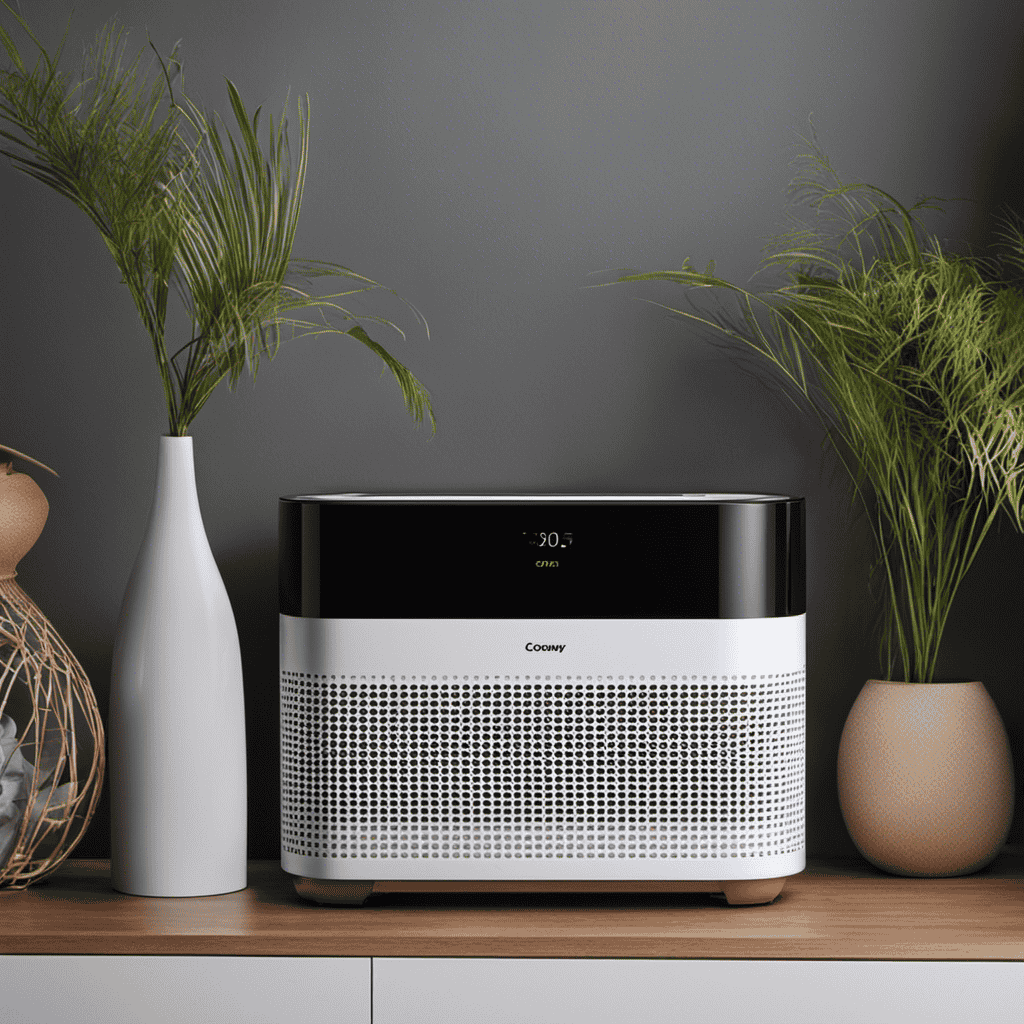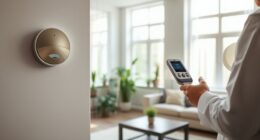UV-C light air purifiers do kill many germs, including viruses and bacteria, by using ultraviolet radiation to damage their genetic material. They work by exposing passing air to UV-C light, which inactivates microorganisms quickly and effectively. However, their safety and effectiveness depend on proper device design and maintenance. If you want to understand how these systems can best protect your indoor air quality, keep exploring the details behind their operation and precautions.
Key Takeaways
- UV-C light damages the DNA/RNA of airborne microorganisms, preventing their reproduction and inactivating viruses, bacteria, and mold spores.
- Properly designed UV-C air purifiers are scientifically proven to reduce airborne pathogens effectively.
- Safety measures like shielding and automatic shut-offs are essential to prevent skin and eye injuries from UV-C exposure.
- Effectiveness depends on device quality, UV intensity, exposure time, and maintenance; not all devices work equally well.
- UV-C air purifiers can complement filtration methods but may produce ozone, requiring careful selection and handling.
How UV-C Light Air Purifiers Work
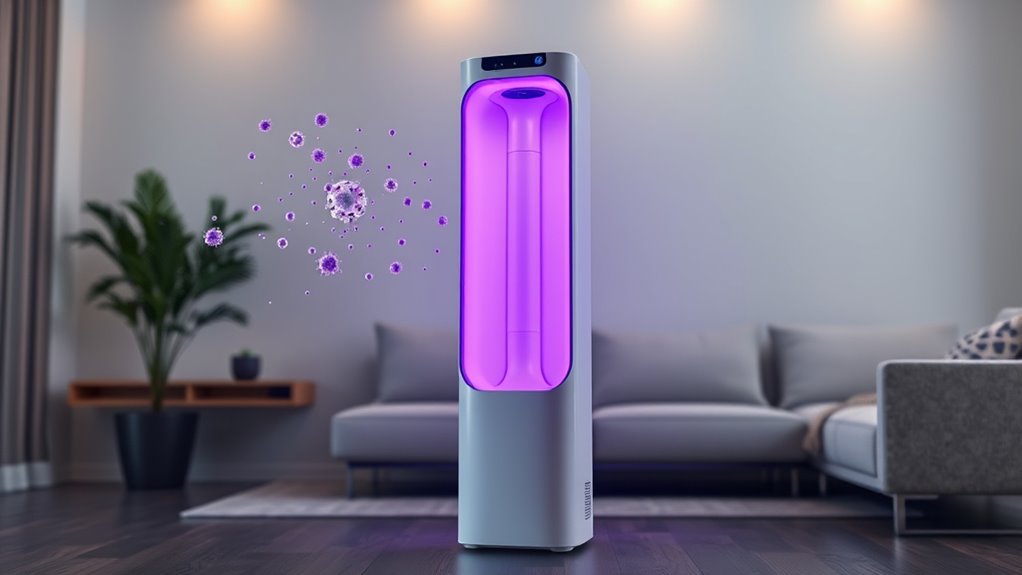
UV-C light air purifiers work by using ultraviolet light in the C spectrum to eliminate airborne pathogens. The UV C wavelength, typically between 200 and 280 nanometers, is essential for targeting microorganisms. When air passes through the purifier, the UV-C light exposes bacteria, viruses, and mold spores to intense germicidal energy. This exposure damages their DNA or RNA, rendering them inactive and unable to reproduce. The germicidal efficiency of UV-C light is highest within this wavelength range, making it an effective method for disinfecting the air. HEPA filtration can be combined with UV-C technology for enhanced removal of allergens and pollutants. Additionally, air circulation within the device ensures that more air is exposed to the UV-C light for better sterilization results. UV-C light effectiveness depends on the exposure time and intensity, which can vary among different purifiers. Proper maintenance and replacement of UV-C bulbs are essential for maintaining their germicidal performance, ensuring continued effectiveness over time. As a result, UV-C air purifiers can considerably reduce airborne illnesses and improve indoor air quality. Their design ensures that pathogens are neutralized quickly, providing a safer environment.
The Science Behind UV-C Germicidal Action
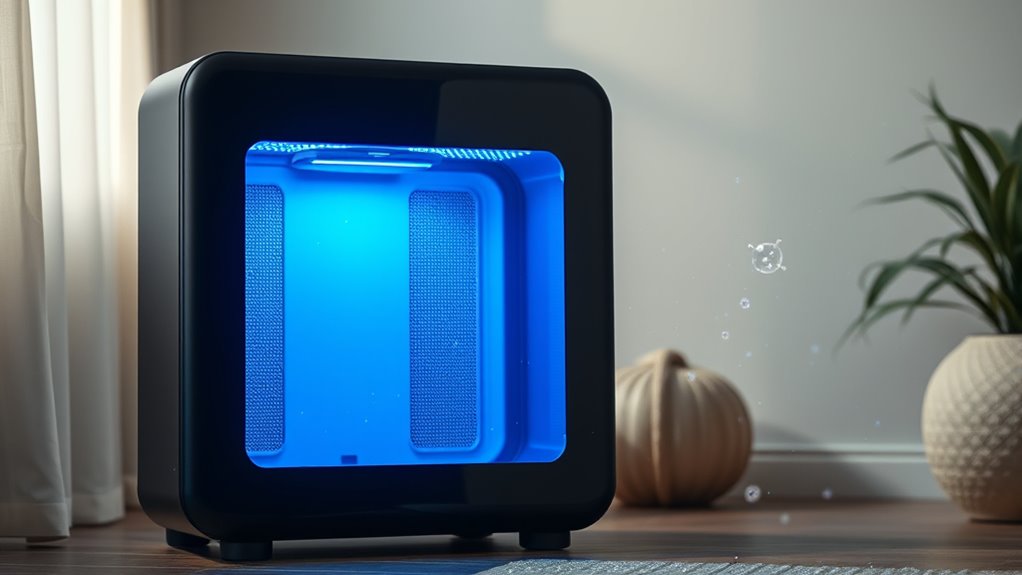
The germicidal power of UV-C light stems from its ability to damage the genetic material of microorganisms. This occurs because the UV-C wavelength, typically between 200 and 280 nanometers, lies within the germicidal spectrum, which effectively disrupts DNA and RNA. When microorganisms absorb UV-C photons, their genetic code becomes damaged, preventing reproduction and rendering them harmless. This process is highly efficient at neutralizing bacteria, viruses, and fungi. The specific wavelength plays an essential role; UV-C around 254 nanometers is most effective for germicidal action. As a result, UV-C light can sterilize surfaces and air by breaking down the genetic material that allows pathogens to survive and multiply. Additionally, understanding the wavelength effectiveness of UV-C is crucial for optimizing sterilization protocols. UV-C light also has applications in medical sterilization and water treatment, demonstrating its broad antimicrobial potential. The safety precautions associated with UV-C devices are important to ensure they are used correctly to prevent harm to humans. Proper device design, including shielding and interlocks, helps mitigate potential risks during operation. Advances in UV-C technology are making these devices safer and more effective for everyday use. Your air purifier utilizes this science to reduce harmful microbes safely and effectively.
Types of UV-C Air Purification Devices
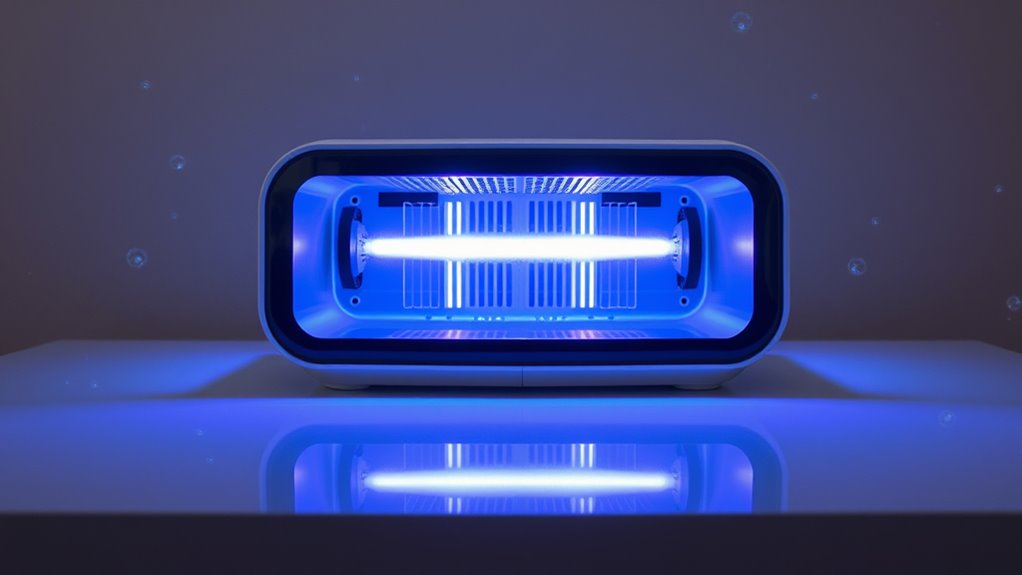
Have you ever wondered how different UV-C air purification devices work to keep your environment clean? There are mainly three types: in-duct systems, portable units, and integrated air purifiers. In-duct systems are installed directly into your HVAC system, requiring careful device installation for peak performance. Portable units sit in rooms, emitting UV-C light to treat the air locally, but their UV C lamp longevity depends on usage and maintenance. Their effectiveness can be enhanced by proper placement and regular lamp replacement UV-C lamp maintenance, ensuring continued germicidal action. Proper device placement is crucial for maximizing the efficiency of portable units and integrated purifiers, as it affects airflow and exposure. Integrated air purifiers combine UV-C technology with filters, offering continuous air cleaning. Each device type varies in size, installation complexity, and maintenance needs. Knowing these options helps you choose the right fit for your space, ensuring effective germ control while considering factors like UV C lamp longevity and proper setup. UV-C technology is effective at deactivating a wide range of germs and viruses when used correctly and maintained regularly. Additionally, selecting a device with an appropriate UV-C dose is essential for optimal germicidal efficacy. Proper device maintenance not only extends the lifespan of the UV-C lamps but also maintains the device’s overall effectiveness in germicidal action.
Effectiveness Against Common Airborne Pathogens
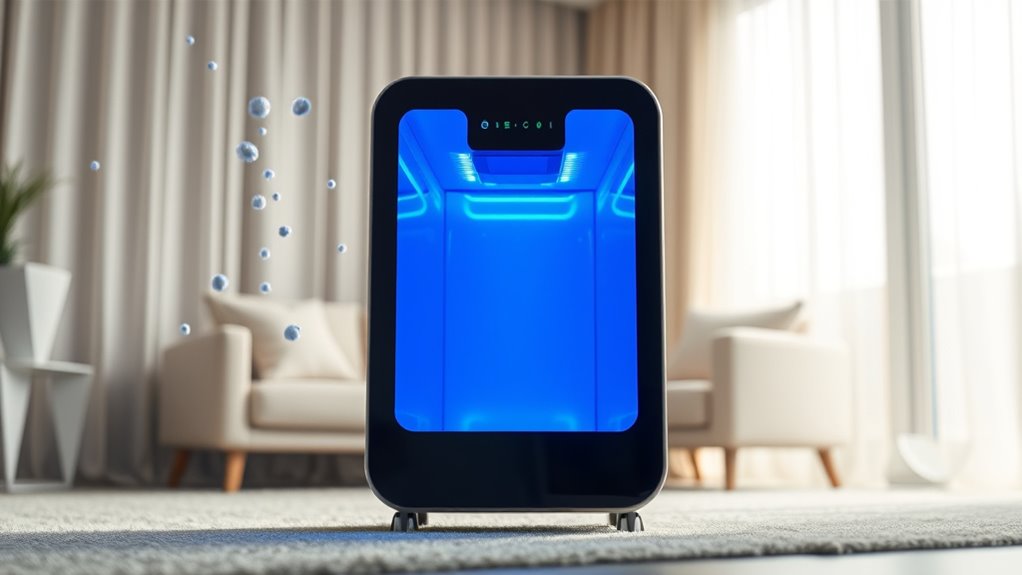
UV-C light has been proven highly effective at neutralizing a wide range of common airborne pathogens, including viruses, bacteria, and fungi. By using UV C technology, your air purifier can break down the DNA and RNA of these microorganisms, preventing them from causing infections. UV-C technology can be optimized to target specific pathogen types for better results. Additionally, the wavelength range of UV-C light is critical for maximizing germicidal effects while minimizing potential side effects. However, some devices may produce ozone as a byproduct, which can pose health concerns. Here’s a quick comparison:
| Pathogen Type | Effectiveness | Ozone Production |
|---|---|---|
| Viruses | Highly effective | Varies, check device specs |
| Bacteria | Very effective | Sometimes, depending on design |
| Fungi | Effective | Usually minimal |
| Allergens | Not directly | No |
| Mold spores | Effective | Rarely |
While UV-C technology kills many pathogens, always consider ozone production levels for safe use. Understanding the differences in ozone output can help you choose a safer device, especially given AI security concerns related to device safety standards.
Safety Considerations and Potential Risks
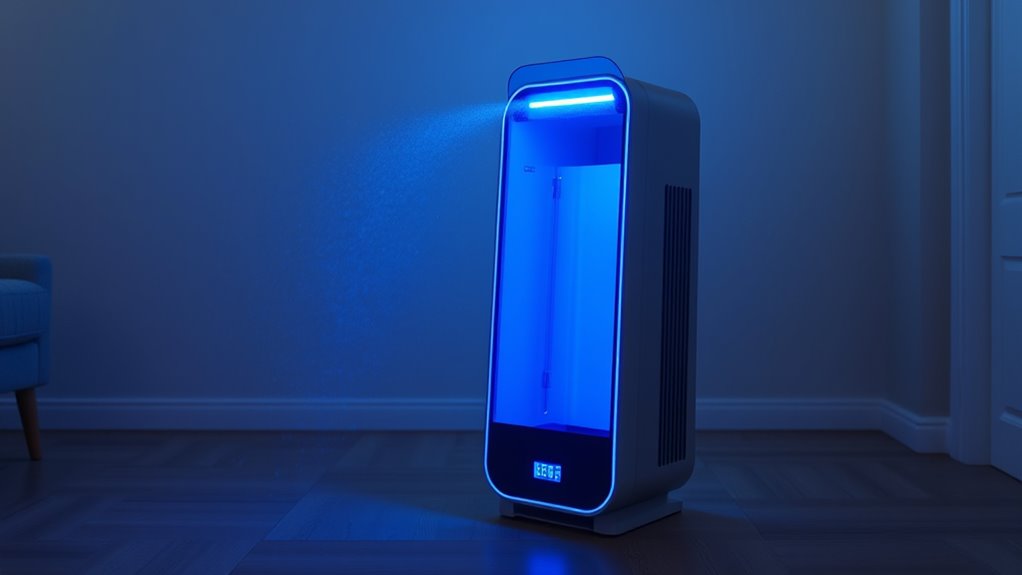
You need to be aware that UV-C light can cause skin and eye injuries if you’re exposed directly. Always handle the device carefully and follow safety instructions to prevent accidental exposure. Understanding these risks helps you use UV-C air purifiers safely and effectively. Additionally, incorporating cultural intelligence into safety protocols can improve staff training and ensure proper handling in diverse workplaces. Being aware of the safety considerations associated with UV-C devices is essential for minimizing health hazards. Furthermore, recognizing that UV-C efficacy depends on correct usage can prevent ineffective treatment and potential safety issues. Proper training and industry trends can help users stay updated on best practices for device safety and effectiveness. An awareness of risk mitigation strategies can also enhance overall safety during operation.
UV-C Exposure Hazards
Although UV-C light is effective at neutralizing airborne pathogens, improper exposure can pose serious health risks. Direct exposure to UV-C can cause skin burns and eye injuries, so you should always avoid looking directly at the light source. Additionally, some UV-C devices produce ozone as a byproduct, which can irritate your respiratory system and worsen asthma symptoms. Over time, UV-C exposure may also lead to material degradation, damaging plastics and rubber components within the device or nearby objects. This degradation not only shortens the lifespan of your purifier but may release harmful particles into your environment. To stay safe, confirm your device has proper shielding and follows safety guidelines, preventing accidental exposure and minimizing risks associated with ozone production and material deterioration. Furthermore, considering the security of your home environment, it’s important to ensure your air purifier’s safety features are up to date to protect your household from potential hazards. Implementing proper safety measures can help reduce the likelihood of accidental UV-C exposure and prolong the device’s effectiveness. Regularly inspecting your device for signs of wear and UV-C light damage can also contribute to safer operation and better health protection. Being aware of the technological limitations of UV-C sterilization can help you make more informed decisions about your air purification needs.
Proper Device Handling
Proper handling of UV-C air purifiers is essential to guarantee safety and maintain device effectiveness. Always follow the manufacturer’s instructions for device maintenance, such as replacing bulbs or cleaning filters, to assure maximum performance. Be cautious to avoid direct exposure to UV-C light, as it can harm your skin and eyes, risking user safety. When handling the device, turn it off and unplug it before performing any maintenance or adjustments. Keep the device out of reach of children and pets to prevent accidental exposure. Regularly inspect the unit for damage or wear, and replace parts promptly. Proper device handling minimizes the risk of UV-C exposure and ensures your air purifier continues to effectively eliminate germs without compromising safety. Additionally, understanding potential pitfalls in adopting new payment technologies can help businesses avoid operational disruptions when integrating such devices.
Comparing UV-C Purifiers to Other Air Filtration Methods
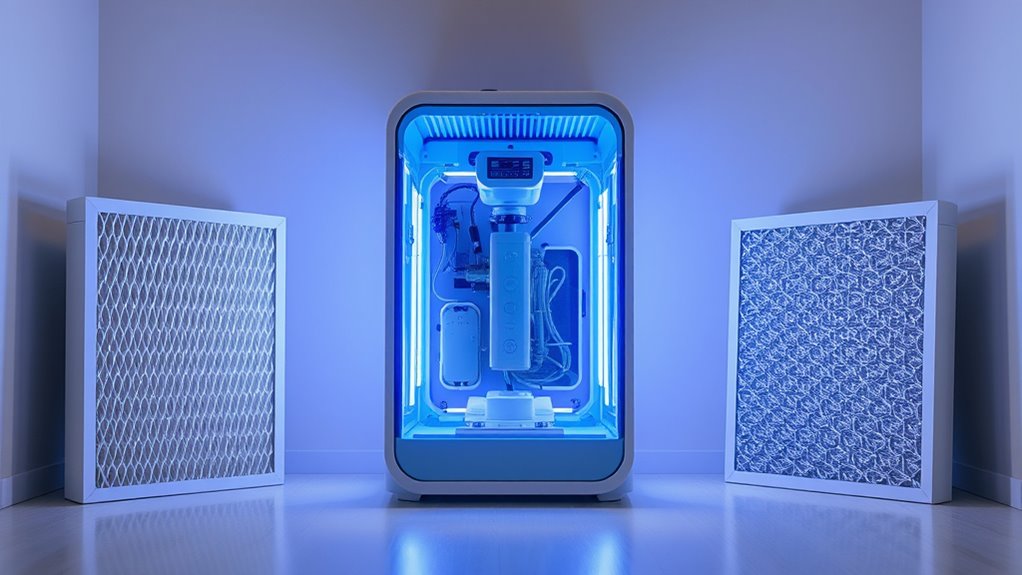
UV-C purifiers stand out by actively inactivating bacteria and viruses using ultraviolet light, but they are just one option among various air filtration methods. While UV-C uses specific UV C wavelength to neutralize germs, filters like HEPA trap particles without killing microorganisms. Some purifiers generate ozone, which can help reduce odors but may pose health risks. Here’s a quick comparison:
| Method | Germ Killing Ability | Ozone Generation | Maintenance Needs | Cost |
|---|---|---|---|---|
| UV-C Purifiers | Kills microbes | Yes/No | Medium | Moderate |
| HEPA Filters | Traps particles | No | Low | Affordable |
| Activated Carbon | Absorbs odors | No | Low | Affordable |
Choose based on your needs—germ inactivation, odor removal, or allergen filtration.
Real-World Evidence and Scientific Studies
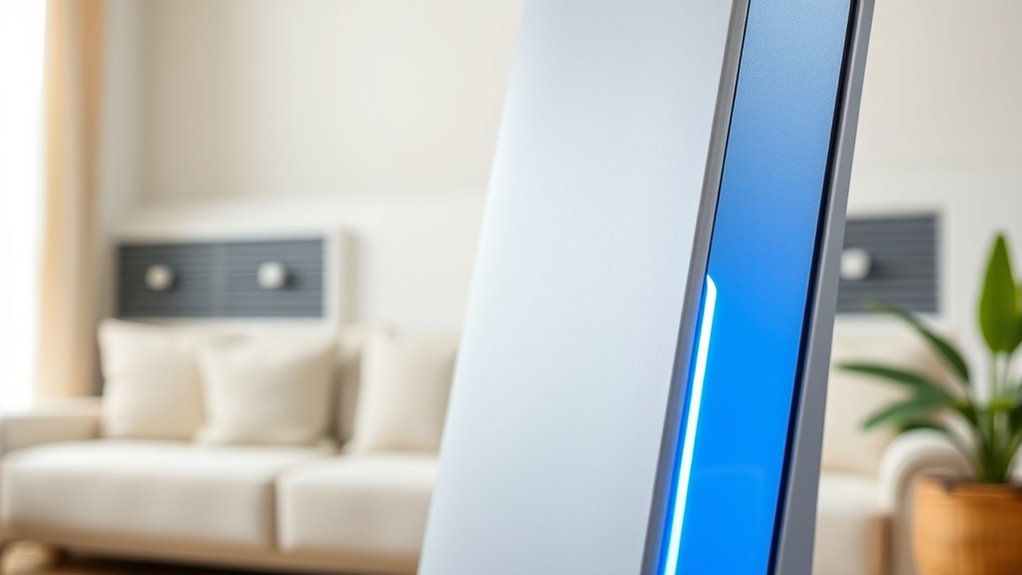
Scientific studies and real-world evidence demonstrate that UV-C air purifiers can effectively reduce airborne microorganisms and improve indoor air quality. Research on UV C efficacy confirms these devices can inactivate viruses and bacteria when properly designed and maintained. Germicidal validation studies show that UV-C light disrupts microbial DNA, leading to cell death. For example, laboratory tests reveal significant pathogen reduction within minutes of exposure. In real-world settings, many users report cleaner air and fewer respiratory issues. However, the effectiveness depends on factors like UV intensity, exposure time, and airflow. Consider these aspects when evaluating UV-C air purifiers.
- Efficacy varies based on design and placement
- Proper maintenance prevents reduced germicidal power
- Scientific validation supports claims of microbial inactivation
- Real-world results depend on correct usage
- UV-C effectiveness is confirmed through germicidal validation
Tips for Choosing an Effective UV-C Air Purifier
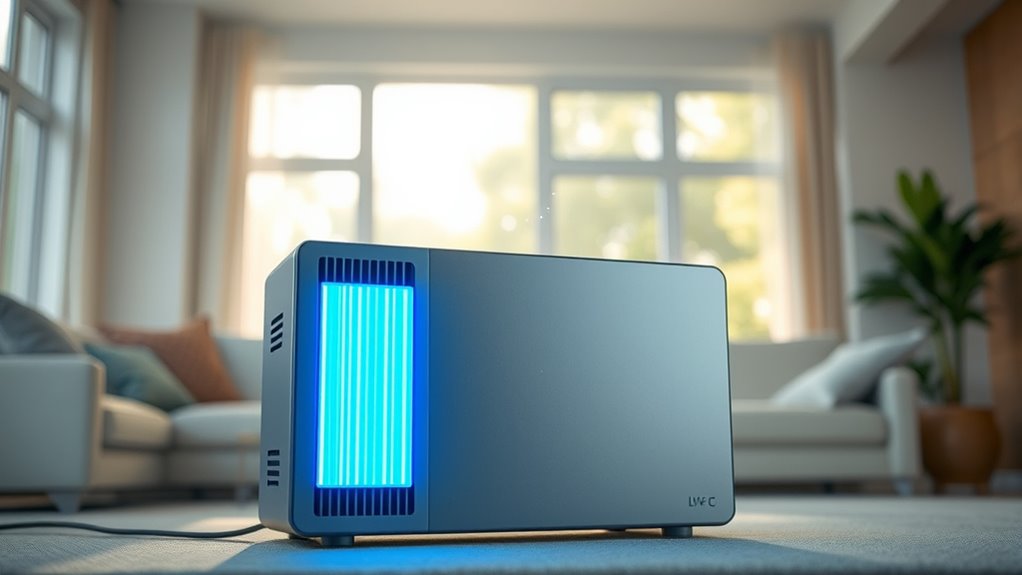
When selecting an effective UV-C air purifier, it’s essential to contemplate key factors that influence its performance. First, confirm the device prioritizes UV C safety by having features like shielding or automatic shut-off to prevent human exposure. Next, consider the quality of the UV-C light source; high-quality bulbs last longer and are more effective at germ-killing. Additionally, check how easy it is to perform device maintenance—regular cleaning of filters and replacing UV bulbs ensures ideal operation. Look for models with clear instructions for upkeep and safety features that prevent accidental exposure. Choosing a purifier with these aspects in mind helps you maximize germicidal efficiency while maintaining safety and ensuring the device remains effective over time.
Frequently Asked Questions
Can UV-C Air Purifiers Eliminate All Viruses and Bacteria?
You wonder if UV-C air purifiers can eliminate all viruses and bacteria. While they considerably improve air purification and help with germ elimination, they don’t guarantee complete eradication of every microorganism. UV-C light effectively destroys many pathogens on surfaces and in the air, but factors like device placement, airflow, and virus type influence their effectiveness. So, they’re a strong tool but shouldn’t be solely relied upon for total germ elimination.
Do UV-C Air Purifiers Produce Harmful Ozone?
You might wonder if UV-C air purifiers produce harmful ozone. While some models can generate ozone through ozone production, many modern units are designed to mitigate this risk. Ozone production can pose health risks, especially for those with respiratory issues. To guarantee safety, choose a purifier certified to limit ozone output, and always follow the manufacturer’s guidelines. This way, you enjoy cleaner air without exposing yourself to unnecessary health risks.
How Long Does It Take for UV-C Light to Kill Germs?
You’re curious about UV-C efficacy and germicidal timing. Typically, UV-C light can kill germs in just a few seconds to minutes, depending on their type and concentration. For air purifiers, the germicidal timing usually ranges from 5 to 15 seconds, ensuring quick disinfection. Keep in mind that essential UV-C exposure and proper airflow are vital to maximize germicidal effectiveness, so follow manufacturer guidelines for best results.
Are UV-C Air Purifiers Effective in Large or Open Spaces?
Did you know that UV-C air purifiers can effectively cover spaces up to 300 square feet? In large or open areas, their effectiveness depends on proper air circulation and adequate space coverage. If airflow isn’t sufficient, germs may linger. To maximize germ-killing power, verify the purifier is suited for the room size and that air moves through it frequently. Proper placement boosts overall air sanitation.
Can UV-C Light Damage My Health or Cause Skin Burns?
You might wonder if UV-C light can harm your health or cause skin burns. While UV safety is important, most UV-C air purifiers are designed to prevent skin exposure by containing the UV light within the device. Direct skin exposure is minimal, but it’s best to avoid staring directly at the light or placing your skin too close. Proper usage guarantees protection and effective germ elimination without risking skin damage.
Conclusion
UV-C air purifiers can effectively reduce airborne germs, offering a valuable layer of protection. Studies show they can kill up to 99.9% of certain bacteria and viruses, making them a promising option for cleaner indoor air. Just remember to choose a device that’s safe and suited to your needs. With the right purifier, you can breathe easier knowing you’re actively fighting germs—especially since indoor air can contain up to five times more pollutants than outdoor air.
